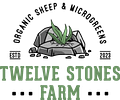Today, I will be sharing with you all some practical tips to make setting up temporary paddocks for intensive rotational grazing more efficient. These are some tricks I have learned from over a year of setting up paddocks every day.
If you are not already rotationally grazing your animals, I highly encourage you to look into it (specifically the intensive, high-density variant). Even if you feed grain, rotationally grazing disrupts the lifecycle of parasites and disease-causing organisms keeping your animals healthy. I plan to write a rotational grazing 101 article or series of articles to introduce this concept at a basic, fundamental level that anyone can understand.
- Once you have learned how big of a paddock you need to build for the duration the livestock will be in it, count and set aside all of the posts you will need to make that paddock plus one or two in case you miscounted or you need an extra post to set in a dip or on a raise. This will allow you to carry only the posts you need so that you are not fumbling around with any extra posts.
Note: always look at the portion of the field you are about to give them and adjust your paddock sizes as needed. Sometimes you need to make it larger or smaller depending on forage density/quality/type, season, and rainfall. - Set your step-in posts spacing roughly 15-18ft apart for sheep. I am 6’2 and this is approximately 6 paces for me at a comfortable stride. For cattle, 30-36ft apart, which is about 10-12 paces for me. Measure out the distance one time and figure out how many paces that is for you at a comfortable stride while carrying a bundle of posts.
- Walk and throw your posts before stepping them in at the approximate distance. Then either step them in after you have thrown all of your posts or run your reels (without clipping them onto the posts) and then step in your posts and clip in your wire(s) at the same time.
- Don’t make sudden stops while reeling out your wire without making the reel stop spinning as you stop or you risk making a mess. Place the reel against your thigh and let the friction make it stop.
- Use an ATV to tromp or a small bush hog (3-4ft) to cut a path for your posts when building paddocks in thick brush, especially if you are running more than one strand of wire at the top (like you would for cattle). This will keep your fence from being grounded out and save you time from having to trample it down yourself.
- This goes along with tip #1, after you move your animals into a new paddock and tear down the old, place the posts you tore down next to the new paddock (either where it is convenient or where you’re going to set the next one) to give you the amount of posts you need, pre-counted for you. Remember to always adhere to the point that I noted.
If you haven’t subscribed already, be sure to do that to receive monthly farm updates and email notifications when we publish new content. Plus, get a copy of our free e-book, “Start Your Sheep Farm Today: A Beginner’s Guide to Infrastructure” when you sign up. Tons of great information all in one place to help you get started.
Send us an email at office@twelvestones.farm any time you have questions and we will be glad to help you in any way we can.
| Whether you turn to the right or to the left, your ears will hear a voice behind you, saying, “This is the way; walk in it.” – Isaiah 30:21

